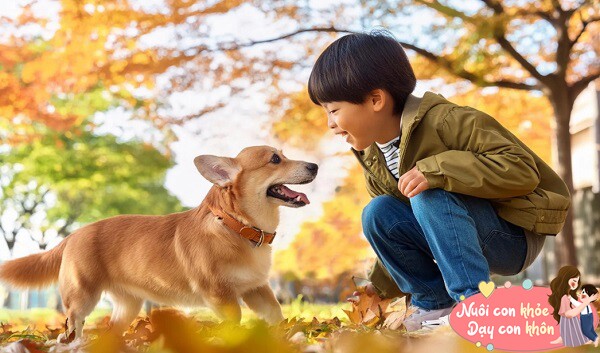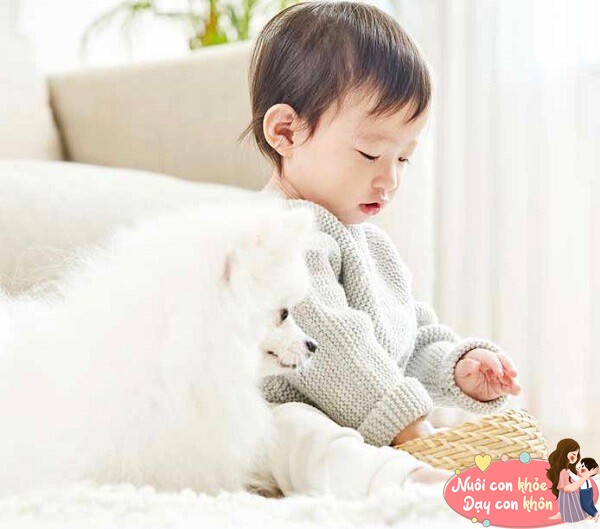There are mixed opinions when it comes to whether children should have pets. While some parents believe that having a pet can teach children about love and responsibility and is thus beneficial, others may have concerns about the potential challenges and responsibilities involved.
In reality, there is no one-size-fits-all answer to this question. It largely depends on the perspectives and living conditions of each family.

What are the benefits of children having pets?
Emotional Development
As children grow up, pets can become loyal and close companions in their lives. For families with only one child, pets can fill the gap between siblings and provide emotional support.
Through interactions with pets, children have the opportunity to learn how to observe and understand the emotions and needs of these small creatures.
Children will learn to read signals from pets, such as sounds, gestures, or facial expressions, and be able to comfort and care for them in a timely manner.

Pets can become loyal companions as children grow up.
Such experiences help children develop empathy and equip them with communication skills, from listening to understanding the emotions of others.
The stable companionship provided by pets can enhance children’s emotional security. Having a “small companion” by their side can make children feel less lonely and anxious when facing life’s challenges.
Social Skills Development
Pets can act as a social bridge, helping children make more friends.
Having a pet allows children to interact with other pet owners and play together, thereby expanding their social circle and learning how to interact with others.
If a child has a pet, they will need to take care of it, play with it, feed it, and clean up after it regularly. Over time, children also learn to cooperate with other family members to better care for the family pet.
Although communicating with pets is not the same as conversing with humans, it still teaches children how to convey information through body language, voice, and expressions.

Pets can act as a social bridge, helping children make more friends.
Fostering a Sense of Responsibility
Pets can teach children about responsibility.
Having a pet means that children need to take on the responsibility of caring for it. Feeding, cleaning, walking, and playing with the pet are all tasks that children should be involved in on a daily basis, fostering a sense of responsibility.
Caring for a pet demands time and energy, and children must learn to balance their time between studying, playing, and caring for their pet. In this way, time management skills are developed.
Pet ownership is not an easy task and requires long-term care and commitment. As children bond with their pets, they will gradually understand the weight of commitment and learn to take responsibility for their decisions.

What should parents consider when allowing their children to have pets?
Allowing children to have pets can indeed have positive effects on their development.
Of course, it is important to remember that everything has its pros and cons, and we cannot ignore the potential challenges that may arise.
To maximize the benefits of pet ownership and ensure the well-being of the child, parents should consider the following aspects:
Choosing the Right Pet
It is crucial to select a pet that is suitable for the child’s age, interests, and living environment.
For younger children, low-maintenance pets such as fish or turtles may be a better option.
For older children, rabbits, cats, or small dogs may be preferred, but they will also require more time and energy investment.

Children should understand the characteristics of different types of pets.
Understanding the Pet’s Needs
It is important to educate children about the needs of their pets, as they all have specific habits and require different types of care.
When it comes to cats, children need to regularly clean the litter box, as cats are sensitive to their environment. If the litter box is not kept clean, the cat may feel uncomfortable and refuse to use it, leading to health issues.
Additionally, children should be guided on how to create a comfortable living space for their cat, such as providing a cozy bed and offering toys for entertainment.
In the case of dogs, daily walks and training are essential. Children will learn to communicate with their dogs through basic commands, helping the dog understand and follow their instructions.
By understanding the needs of their pets, parents can better support their children in providing proper care.
Safety Education
It is important to teach children that even the most well-behaved pet can have a “wild” side.
Children should be instructed to be patient and gentle when playing and interacting with their pets to avoid scaring or harming them.

Learning how to care for and play with pets safely is essential.
At the same time, children must be taught to respect their pet’s independence and need for privacy. They should learn not to disturb their pet while it is resting or eating.
If possible, consider gifting your child a pet to enrich their childhood experiences. For children, pets can be like playmates and trusted companions on their journey to adulthood.





































